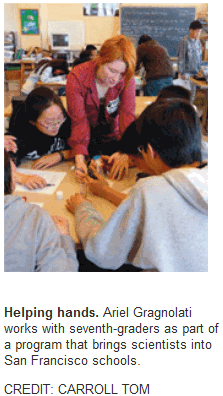
|
|
|
|
|
|
|
News & Views item - December 2009 |
![]() US Scientists Aid Primary and Secondary School Teachers in STEM Education.
(December 22, 2009)
US Scientists Aid Primary and Secondary School Teachers in STEM Education.
(December 22, 2009)
The website is nationallabday.org, which is something of a misnomer. "It's actually a year-long series of activities," explains neuroscientist–turned–serial entrepreneur, Jack Hidary. "We're not interested in another boutique program. We want something that will really galvanize people on a national scale."
Mr Hidary's mission statement is simple: "National Lab Day aims to inspire a wave of future innovators and foster U.S. competitiveness by improving the quality of STEM education in America. A collaboration between government and more than 200 public- and private-sector organizations, National Lab Day will connect students in grades 6-12 to hands-on learning experiences and promote tinkering in laboratory settings."
And the approach is to create a new, interactive Web site as the vehicle to match scientists and classroom teachers across the United States in projects aimed at improving STEM learning.
National Lab Day is part of Educate to Innovate, an initiative of the US private sector which has promised an investment of US$260 million which Science's Jeffrey Mervis describes as being "a variety of projects, some new but many with a long track record, ranging from after-school robotics competitions to educational video games, and from science-themed television shows to better professional development for teachers".
US President Obama told a November 23 rally: "The success we seek [in improving STEM education] is not going to be attained by government alone... [I] encourage folks to think of new and creative ways of engaging young people in science and engineering." And he added that he expects the partnerships formed through the Web site to "reach 10 million young people with hands-on learning" by next spring, when organizers hope the president will keynote a second event to celebrate its success.
Mr Hidary told Science that the idea for the Web site was hatched some 3 months ago in a meeting with officials from the White House Office of Science and Technology Policy (OSTP). "A number of us were involved in TechNet Day."
Science also spoke with Rebecca Smith who is co-director of the Science and Health Education Partnership (SEP), which since 1987 has been drawing from the large population of academic scientists in the Bay Area and matching them with San Francisco schoolteachers (biochemistry.ucsf.edu/programs/sep). She praises Hidary's initiative for trying to reach areas that lack such a large talent pool, but also cautions: Take the time to make good matches, don't expect too much, monitor the partnerships closely, and stick with it -- but the most important ingredient, mutual respect and trust.
And Mr Hidary's concluding comment? "We already know that project-based, hands-on learning works; the challenge now is to scale up. And the only way to do that is through massive partnerships."